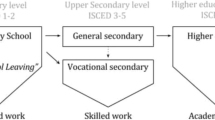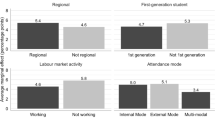Abstract
Purpose
The objective of the current study was to quantify the extent to which Australia’s tertiary students have reported poorer mental health in comparison with the general community between 2001 and 2017.
Methods
Data were derived from the Household, Income and Labour Dynamics in Australia Survey, a longitudinal household-based panel study. There were 29,124 participants who provided at least one observation over the study period. On average, participants provided 7.4 observations. Mental Health was assessed with the SF-36 mental health and vitality subscales.
Results
There was little evidence for differences in mental health and vitality between those studying at tertiary levels and those not in tertiary education. Age-stratified analyses revealed that any differences were reported by older students. Interactions between education level and time revealed that the association between tertiary study and mental health outcomes has been consistent over time.
Conclusion
There were very few differences between those in and those not in tertiary education. The magnitude of any differences was very small and does not necessarily reflect substantial poor mental health outcome. Overall, the most consistent finding was that there was little risk for poor mental health outcomes attributed to tertiary study.
Similar content being viewed by others
References
Kessler RC, Amminger GP, Aguilar-Gaxiola S, Alonso J, Lee S, Ustun TB (2007) Age of onset of mental disorders: a review of recent literature. Curr Opin Psychiatry 20(4):359–364. https://doi.org/10.1097/YCO.0b013e32816ebc8c
Slade T, Johnston A, Oakley Browne MA, Andrews G, Whiteford H (2009) 2007 national survey of mental health and wellbeing: methods and key findings. Aust N Z J Psychiatry 43(7):594–605. https://doi.org/10.1080/00048670902970882
Leahy CM, Peterson RF, Wilson IG, Newbury JW, Tonkin AL, Turnbull D (2010) Distress levels and self-reported treatment rates for medicine, law, psychology and mechanical engineering tertiary students: cross-sectional study. Aust N Z J Psychiatry 44(7):608–615. https://doi.org/10.3109/00048671003649052
Stallman HM (2010) Psychological distress in university students: a comparison with general population data. Aust Psychol 45(4):249–257. https://doi.org/10.1080/00050067.2010.482109
Vivekananda K, Telley A, Trethowan S (2011) A five year study on psychological distress within a university counselling population. J Aust N Z Stud Serv Assoc 37:39–57
Auerbach RP, Alonso J, Axinn WG, Cuijpers P, Ebert DD, Green JG, Hwang I, Kessler RC, Liu H, Mortier P, Nock MK, Pinder-Amaker S, Sampson NA, Aguilar-Gaxiola S, Al-Hamzawi A, Andrade LH, Benjet C, Caldas-de-Almeida JM, Demyttenaere K, Florescu S, de Girolamo G, Gureje O, Haro JM, Karam EG, Kiejna A, Kovess-Masfety V, Lee S, McGrath JJ, O’Neill S, Pennell BE, Scott K, Ten Have M, Torres Y, Zaslavsky AM, Zarkov Z, Bruffaerts R (2016) Mental disorders among college students in the World Health Organization World Mental Health Surveys. Psychol Med 46(14):2955–2970. https://doi.org/10.1017/s0033291716001665
Bayram N, Bilgel N (2008) The prevalence and socio-demographic correlations of depression, anxiety and stress among a group of university students. Soc Psychiatry Psychiatr Epidemiol 43(8):667–672. https://doi.org/10.1007/s00127-008-0345-x
Ibrahim AK, Kelly SJ, Adams CE, Glazebrook C (2013) A systematic review of studies of depression prevalence in university students. J Psychiatr Res 47(3):391–400. https://doi.org/10.1016/j.jpsychires.2012.11.015
Stewart-Brown S, Evans J, Patterson J, Petersen S, Doll H, Balding J, Regis D (2000) The health of students in institutes of higher education: an important and neglected public health problem? J Public Health Med 22(4):492–499
Adewuya AO, Ola BA, Aloba OO, Mapayi BM, Oginni OO (2006) Depression amongst Nigerian university students. Soc Psychiatry Psychiatr Epidemiol 41(8):674–678. https://doi.org/10.1007/s00127-006-0068-9
Tong J, Miao S, Wang J, Yang F, Lai H, Zhang C, Zhang Y, Hsu LK (2014) A two-stage epidemiologic study on prevalence of eating disorders in female university students in Wuhan, China. Soc Psychiatry Psychiatr Epidemiol 49(3):499–505. https://doi.org/10.1007/s00127-013-0694-y
Verger P, Combes J-B, Kovess-Masfety V, Choquet M, Guagliardo V, Rouillon F, Peretti-Wattel P (2009) Psychological distress in first year university students: socioeconomic and academic stressors, mastery and social support in young men and women. Soc Psychiatry Psychiatr Epidemiol 44(8):643–650. https://doi.org/10.1007/s00127-008-0486-y
Rickwood D, Telford N, O’Sullivan S, Crisp D, Magyar R (2017) National tertiary student wellbeing survey 2016. Headspace & National Union of Students
(ABS) ABoS (2015) Psychological distress .4364.0.55.001—national health survey: first results, 2014–15. Commonwealth of Australia, Canberra
Hope V, Henderson M (2014) Medical student depression, anxiety and distress outside North America: a systematic review. Med Educ 48(10):963–979. https://doi.org/10.1111/medu.12512
Mata DA, Ramos MA, Bansal N, Khan R, Guille C, Di Angelantonio E, Sen S (2015) Prevalence of depression and depressive symptoms among resident physicians: a systematic review and meta-analysis. J Am Med Assoc 314(22):2373–2383. https://doi.org/10.1001/jama.2015.15845
Brown J (2018) Student mental health: some answers and more questions AU—Brown, June S. L. J Ment Health 27(3):193–196. https://doi.org/10.1080/09638237.2018.1470319
Eisenberg D, Hunt J, Speer N, Zivin K (2011) Mental health service utilization among college students in the United States. J Nerv Ment Dis 199(5):301–308. https://doi.org/10.1097/NMD.0b013e3182175123
Voelker R (2003) Mounting student depression taxing campus mental health services. J Am Med Assoc 289(16):2055–2056. https://doi.org/10.1001/jama.289.16.2055
Cvetkovski S, Reavley NJ, Jorm AF (2012) The prevalence and correlates of psychological distress in Australian tertiary students compared to their community peers. Aust N Z J Psychiatry 46(5):457–467. https://doi.org/10.1177/0004867411435290
Blanco C, Okuda M, Wright C, Hasin DS, Grant BF, Liu SM, Olfson M (2008) Mental health of college students and their non-college-attending peers: results from the National Epidemiologic Study on Alcohol and Related Conditions. Arch Gen Psychiatry 65(12):1429–1437. https://doi.org/10.1001/archpsyc.65.12.1429
Sarmento M (2015) A “mental health profile” of higher education students. Proced Soc Behav Sci 191:12–20. https://doi.org/10.1016/j.sbspro.2015.04.606
Hawton K, Bergen H, Mahadevan S, Casey D, Simkin S (2012) Suicide and deliberate self-harm in Oxford University students over a 30-year period. Soc Psychiatry Psychiatr Epidemiol 47(1):43–51. https://doi.org/10.1007/s00127-010-0310-3
Collins IP, Paykel ES (2000) Suicide amongst Cambridge University Students 1970–1996. Soc Psychiatry Psychiatr Epidemiol 35(3):128–132. https://doi.org/10.1007/s001270050195
Wilson T, Shalley F (2018) Estimates of Australia’s non-heterosexual population. Aust Popul Stud 2(1):2018
Cvetkovski S, Jorm AF, Mackinnon AJ (2019) An analysis of the mental health trajectories of university students compared to their community peers using a national longitudinal survey. Stud Higher Educ 44(1):185–200. https://doi.org/10.1080/03075079.2017.1356281
Wooden M, Watson N (2007) The HILDA survey and its contribution to economic and social research (so far). Econ Rec 83(261):208–231. https://doi.org/10.1111/j.1475-4932.2007.00395.x
Wooden M, Warren D (2004) Non-standard employment and job satisfaction: evidence from the Hilda Survey. J Ind Relat 46(3):275–297. https://doi.org/10.1111/j.0022-1856.2004.00142.x
Ware JE Jr, Sherbourne CD (1992) The MOS 36-item short-form health survey (SF-36). I. Conceptual framework and item selection. Med Care 30(6):473–483
Butterworth P, Crosier T (2004) The validity of the SF-36 in an Australian National Household Survey: demonstrating the applicability of the Household Income and Labour Dynamics in Australia (HILDA) Survey to examination of health inequalities. BMC Public Health 4:44. https://doi.org/10.1186/1471-2458-4-44
Rumpf HJ, Meyer C, Hapke U, John U (2001) Screening for mental health: validity of the MHI-5 using DSM-IV Axis I psychiatric disorders as gold standard. Psychiatry Res 105(3):243–253
Yamazaki S, Fukuhara S, Green J (2005) Usefulness of five-item and three-item Mental Health Inventories to screen for depressive symptoms in the general population of Japan. Health Qual Life Outcomes 3:48. https://doi.org/10.1186/1477-7525-3-48
Skapinakis P, Lewis G, Araya R, Jones K, Williams G (2005) Mental health inequalities in Wales, UK: multi-level investigation of the effect of area deprivation. Br J Psychiatry 186:417–422
Gill SC, Butterworth P, Rodgers B, Anstey KJ, Villamil E, Melzer D (2006) Mental health and the timing of men’s retirement. Soc Psychiatry Psychiatr Epidemiol 41(7):515–522. https://doi.org/10.1007/s00127-006-0064-0
Huppert FA, Marks N, Clark A, Siegrist J, Stutzer A, Vittersø J, Wahrendorf M (2009) measuring well-being across Europe: description of the ESS well-being module and preliminary findings. Soc Indic Res 91(3):301–315. https://doi.org/10.1007/s11205-008-9346-0
Kasser T, Ryan RM (1996) Further examining the American dream: differential correlates of intrinsic and extrinsic goals. Pers Soc Psychol B 22(3):280–287
Ryan RM, Frederick C (1997) On energy, personality, and health: subjective vitality as a dynamic reflection of well-being. J Pers Soc Psychol 65(3):529–565
Nix GA, Ryan RM, Manly JB, Deci EL (1999) Revitalization through self-regulation: the effects of autonomous and controlled motivation on happiness and vitality. J Exp Soc Psychol 35(3):266–284
Bjorner JB, Wallenstein GV, Martin MC, Lin P, Blaisdell-Gross B, Tak Piech C, Mody SH (2007) Interpreting score differences in the SF-36 Vitality scale: using clinical conditions and functional outcomes to define the minimally important difference. Curr Med Res Opin 23(4):731–739. https://doi.org/10.1185/030079907X178757
Croog SH, Levine S, Testa MA, Brown B, Bulpitt CJ, Jenkins CD, Klerman GL, Williams GH (1986) The effects of antihypertensive therapy on the quality of life. N Engl J Med 314(26):1657–1664. https://doi.org/10.1056/NEJM198606263142602
Fowler FJ Jr, Wennberg JE, Timothy RP, Barry MJ, Mulley AG Jr, Hanley D (1988) Symptom status and quality of life following prostatectomy. JAMA 259(20):3018–3022
Burns RA, Byles J, Mitchell P, Anstey KJ (2012) Positive components of mental health provide significant protection against likelihood of falling in older women over a 13-year period. Int Psychogeriatr 24(9):1419–1428
Burns R, Sargent-Cox K, Mitchell P, Anstey K (2014) An examination of the effects of intra and inter-individual changes in wellbeing and mental health on self-rated health in a population study of middle and older-aged adults. Soc Psychiatry Psychiatr Epidemiol 49(11):1849–1858. https://doi.org/10.1007/s00127-014-0864-6
Burns RA, Browning CJ, Kendig HL (2015) Examining the 16-year trajectories of mental health and wellbeing through the transition into widowhood. Int Psychogeriatr 27(12):1979–1986. https://doi.org/10.1017/S1041610215000472
Burns RA, Butterworth P, Browning C, Byles J, Luszcz M, Mitchell P, Shaw J, Anstey KJ (2014) Examination of the association between mental health, morbidity, and mortality in late life: findings from longitudinal community surveys. Int Psychogeriatr. https://doi.org/10.1017/s1041610214002051
Burns RA, Byles J, Magliano DJ, Mitchell P, Anstey KJ (2015) The utility of estimating population-level trajectories of terminal wellbeing decline within a growth mixture modelling framework. Soc Psychiatry Psychiatr Epidemiol 50(3):479–487. https://doi.org/10.1007/s00127-014-0948-3
Burns RA, Byles J, Mitchell P, Anstey KJ (2012) Positive components of mental health provide significant protection against likelihood of falling in older women over a 13-year period. Int Psychogeriatr 24(9):1419–1428. https://doi.org/10.1017/S1041610212000154
Burns RA, Mitchell P, Shaw J, Anstey K (2014) Trajectories of terminal decline in the wellbeing of older women: the DYNOPTA project. Psychol Aging 29(1):44–56
StataCorp (2015) Stata statistical software: release 14. StataCorp LP, College Station
Wasserstein RL, Schirm AL, Lazar NA (2019) Moving to a world beyond “p < 0.05”. Am Stat 73(sup1):1–19. https://doi.org/10.1080/00031305.2019.1583913
McAllister M, Wynaden D, Happell B, Flynn T, Walters V, Duggan R, Byrne L, Heslop L, Gaskin C Staff experiences of providing support to students who are managing mental health challenges: a qualitative study from two Australian universities
Thorley C (2017) Not by degrees: improving student health in the UK’s universities. Institute of Public Policy Research
Cuijpers P, Auerbach RP, Benjet C, Bruffaerts R, Ebert D, Karyotaki E, Kessler RC (2019) The World Health Organization World Mental Health International College Student initiative: an overview. Int J Methods Psychiatr Res 28(2):e1761. https://doi.org/10.1002/mpr.1761
Harrer M, Adam SH, Baumeister H, Cuijpers P, Karyotaki E, Auerbach RP, Kessler RC, Bruffaerts R, Berking M, Ebert DD (2019) Internet interventions for mental health in university students: a systematic review and meta-analysis. Int J Methods Psychiatr Res 28(2):e1759. https://doi.org/10.1002/mpr.1759
Lungu A, Sun M (2016) Time for a change: college students’ preference for technology-mediated versus face-to-face help for emotional distress. Telemed J E Health 22(12):991–1000. https://doi.org/10.1089/tmj.2015.0214
Chan JK, Farrer LM, Gulliver A, Bennett K, Griffiths KM (2016) University students’ views on the perceived benefits and drawbacks of seeking help for mental health problems on the internet: a qualitative study. JMIR Hum Factors 3(1):e3. https://doi.org/10.2196/humanfactors.4765
Storrie K, Ahern K, Tuckett A (2010) A systematic review: students with mental health problems—a growing problem. Int J Nurs Pract 16(1):1–6. https://doi.org/10.1111/j.1440-172X.2009.01813.x
Acknowledgements
The research in this paper uses unit record data from the Household, Income and Labour Dynamics in Australia (HILDA) Survey. HILDA is funded by the Australian Government Department of Families, Housing, Community Services and Indigenous Affairs (FaHCSIA) and managed by the Melbourne Institute of Applied Economic and Social Research (Melbourne Institute). The findings and view reported in this paper are those of the authors.
Author information
Authors and Affiliations
Corresponding author
Ethics declarations
Conflict of interest
On behalf of all authors, Richard A. Burns states that there is no conflict of interest.
Rights and permissions
About this article
Cite this article
Burns, R.A., Crisp, D.A. The long-term mental health of Australia’s tertiary students. Soc Psychiatry Psychiatr Epidemiol 55, 1223–1230 (2020). https://doi.org/10.1007/s00127-019-01806-7
Received:
Accepted:
Published:
Issue Date:
DOI: https://doi.org/10.1007/s00127-019-01806-7




